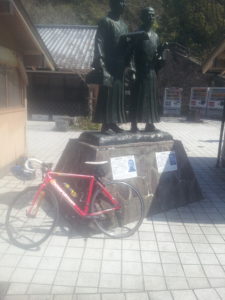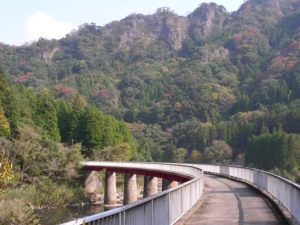【Cycling Diary】Road to Hagi : coast to coast across Yamaguchi

Cycling to Hagi Yamaguchi
Breakfast in preparation for a long day in the saddle.
Departing from Tonomi (Hofu, Yamaguchi) 山口県防府市富海 we took the coastal road west to intersect with the 58 on the outskirts of 防府 Hofu. The views over the inland sea towards Kyushu were stunning and I knew we had chosen a good day for a long ride from coast to coast across 山口 Yamaguchi prefecture.
The route roughly follows historic Hagi Okan 萩往還, an old route used by thousands of samurais and ordinary people since 1600s, linking Mitajiri 三田尻 port (now Hofu) via Yamaguchi 山口 to Hagi 萩. It is an important route used by shishi 志士, politically motivated Choshu 長州 Samurais before the Meiji restoration 明治維新.
Despite it being a Tuesday morning the roads were relatively quiet as we passed through Hofu city. Leaving The city we took the 262 North. The first 3km is a steady 125 m climb out of the city to a 400m tunnel which we ride through on the pavement. Emerging from the tunnel there is a lovely 6km decent towards Yamaguchi. This stretch of the 262 is straight and smooth. There are a number of small convenience shops en route to purchase snacks for the ensuing journey.
It might be tempting to turn left to Yamaguchi or 湯田温泉 Yuda Onsen at the intersection of the 21 however we kept cycling north along a more undulating 262 to the intersection of the 9 where we turned right.
Route 9 is a busy road that runs from 小郡 Ogori all the way to Kyoto. We cycle along it for 3km stopping at Seven eleven for a Karaage (fried chicken) and An man snack in the sunshine before turning immediately left onto the much quieter 196.
The 196 passes through the middle of a ginormous quarry operation with huge catepillar trucks dragging themselves at unbelievable angles up the side of the quarry face.
After the quarry the road begins a more challenging 7-8% incline for 3km to 宮野湖 Lake Miyano. Here, if time allows, it is possible to take a delightful 10km detour around the lake before returning to the 196 to begin the 2.5km 10% climb out of the valley to the 262.
Emerging on to the 262 the landscape is agricultural and dominated by rice production. The 262 is a quiet road with an initial long 10km gently meandering descent into あさひ Asahi. Asahi is on the intersection of the 262, 309 and 10. Turning left the 309 is a challenging route towards Ogori, the 10 is a gentle ascent to the beautiful Abugawa lake and river.
In Asahi we stopped at Michi-no-eki 道の駅, a road side cafe/shop for a snack and toilet break before continuing North. The ladies in the shop were very helpful in replenishing our empty water bottles with fresh water.
Leaving Asahi on the 262 heading north there is a 5km climb to just over 400m before a long 12km sweeping descent towards Hagi. The descent is exhilarating weaving its way through an ever more lush countryside where we witness a number of farmers beginning the preparation of their paddy fields for the forthcoming rice growing season.
The 262 passes through a number of short tunnels where changes to the road surface, from Tarmac to concrete, require careful handling especially when travelling at speed. On the southern outskirts of Hagi we pass through the final tune land stop at Hagi Okan Michi-no-eki 萩往還 道の駅, a small tourist museum/shop where we are able to learn a lot about the history of Hagi.
From medieval times Hagi has played a significant political role in Japan. The city was the capital of western Japan for several centuries, from the 1860's it became the ideological focal point of Meiji restoration and the industrial revolution in the country and the city has spawned several prime ministers.
Upon arrival in Hagi we were tempted by the sandy beach and the prospect of a soothing Onsen in the soft volcanic spring waters associated with the city but alas time wouldn't allow. Instead decided we should eat in preparation for our return journey. The Katsu curry lunch eaten in a local restaurant fitted the bill nicely.
Back in the saddle we retraced our steps in the afternoon.
cycling diary by J (4.4.17)

